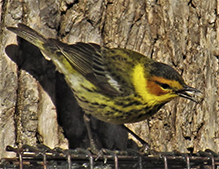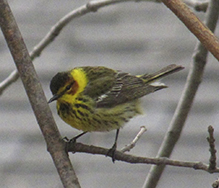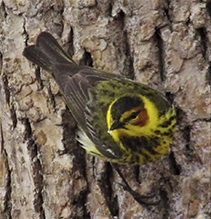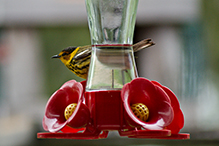Cape May Warbler
(Setophaga tigrina)
Conservation • Description • Habitat • Ecology • Distribution • Taxonomy
|
|
||||||||||||||
Description |
Cape May Warbler is a small perching bird but a medium-sized New World Warbler. Its breeds in Canada from Nova Scotia to the Northwest Territories, and in the United States in northern New England and the Upper Midwest. It winters in the West Indies. In Minnesota it breeds in Arrowhead region. It is an uncommon migrant in most of the state in May and from early August through October. It is rare in the west. Cape May Warbler adult is 4¾″ to 5″ in length and has a wingspan of 7½″to 8¾″. On the breeding male, the upper parts are dark olive green, the chin, sides of the neck (“collar”), and rump are yellow. The crown is dark and the face is yellow. There is a large chestnut-brown ear patch and a dark eye line. The bill is thin, dark, and slightly curved downward. The breast and flanks are yellow with dark stripes that converge on the throat. The undertail coverts are white. On each wing there is a distinct white patch formed by the greater coverts. The tail is short. The female is paler overall and has two thin white wing patches. The crown is olive-gray and there is a grayish cheek patch. |
Size |
4¾″ to 5″ in length 7½″to 8¾″ wingspan |
Voice |
|
|
Similar Species |
Habitat |
Breeding: Mature coniferous and mixed forests Migration: Forests, woodlands, and thickets |
Ecology |
Migration |
May and early August through October |
Nesting |
The nest is built in a mature forest near the top of a tall spruce or balsam fir tree usually near the trunk. |
Food |
Insects, especially spruce budworm; flower nectar; and fruit juices |
Distribution |
Occurrence |
Uncommon migrant, sporadic breeder |
Maps |
The Minnesota Ornithologists’ Union All Seasons Species Occurrence Map |
Taxonomy |
|
Class |
Aves (birds) |
Order |
Passeriformes (perching birds) |
Family |
Parulidae (New World warblers) |
Genus |
Setophaga (Setophaga warblers) |
In 2011 all of the wood warblers were reclassified resulting in new genus names for almost all of them. The genus Dendroica, with 29 members, was merged with the genus Setophaga, with just 3 members. All of the former Dendroica species have been renamed to Setophaga. Cape May Warbler, formerly Dendroica tigrina, is now Setophaga tigrina. |
|
Subordinate Taxa |
|
|
|
Synonyms |
|
Dendroica tigrina |
|
Visitor Photos |
||
Share your photo of this bird. |
||
This button not working for you? |
||
Bill Reynolds |
||
Cape May Warbler First time ever for me. I grew up on the NE side of the state and I don't ever recall spotting this warbler. Today, it was hanging out on a hummingbird feed. It kept getting chased off by Orioles. |
||
Ramona Abrego |
||
 |
 |
|
 |
||
MinnesotaSeasons.com Photos |
||
|
||
|
||

Visitor Videos |
||
Share your video of this bird. |
||
This button not working for you? |
||
|
Other Videos |
||
Setophaga tigrina CAPE MAY WARBLER feeding |
About
Oct 11, 2019 Setophaga tigrina CAPE MAY WARBLER feeding on scale insects, trying for flying insects, scared by wasp, Montrose Point, Chicago, 9/23/2019. |
Cape May Warbler (Setophaga/Dendroica tigrina) |
About
May 20, 2013 This migrant male Cape May Warbler (Setophaga/Dendroica tigrina) takes a brief respite from foraging to dry and vigorously preen on too cold, too wet mid-May day in Grand Forks, North Dakota (20 May 2013). |

Visitor Sightings |
||
Report a sighting of this bird. |
||
This button not working for you? |
||
Ramona Abrego |
Location: Washington County |
 |
MinnesotaSeasons.com Sightings |
||
|

Created: 7/11/2020 Last Updated: © MinnesotaSeasons.com. All rights reserved. |



